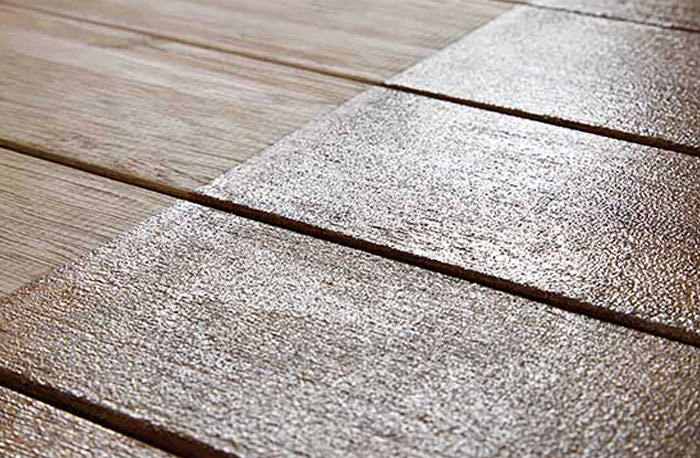
Most people won’t think about how slippery their decking becomes during adverse weather conditions. Instead, they will spend a lot of time dwelling on how good their decking looks, the colour of it and the type of finish. Protecting your decking is extremely important though, as well as the safety of people that will use it.
Avoiding slips and falls that could result in injury is obviously something we’d all like to avoid, and with that in mind, we thought we would offer an insight into how you can go about creating an anti-slip decking for when the weather isn’t that great.

Protecting your Decking from Becoming Slippery
During the winter months, the temperatures drop and the reduction in sunlight leaves more time for algae to form on the surface of your decking, leaving you with a slippery surface that can be potentially dangerous.
In areas of low foot traffic, such as your garden, it is far more common for alae or fungus to build up with sediment from the atmosphere. Rotting leaves or bird mess can contribute to the growth of algae, creating a potentially dangerous and slippery ice-rink that can lead to accidents and injuries.
Slippery decking is one of the most queried issues when it comes to deck maintenance, so it’s important to find out how to go about treating it.
1. Clean your decking
If your decking has become overwhelmed by the elements, it’s time to bring your deck back to life with a quality wood restoring cleaner or restoration product.
An example of a quality wood cleaner is the popular ‘Net-Trol’ product from industry leaders Owatrol, providing users with an environmentally friendly solution that will help to restore the wood back to its natural appearance.
2. Add an anti-slip paint or coating
Once you have cleaned your decking efficiently, you can think about coating it with an anti-slip deck paint or coating. These tend to be a paint, stain or oil with other additives to ensure the surface has even more protection still. Essentially, decking additives will provide an abrasive surface that can help to prevent accidents when the surface is wet.
A range of products can be purchased to help you create an anti-slip surface on your decking. You should take the time to research the best products out there that will protect the surface, maintain its appearance and offer protection to those who walk on the decking.
Creating an anti-slip surface is something a lot of people try to achieve when they first have their decking installed. To ensure your decking remains non-slip, you will need to take extra care to properly apply products, cleaning your decking when it becomes dirty and maintaining it in the right way.
If you are unsure about how to go about creating an anti-slip decking, you should seek technical advice from an experienced paint specialist who will be able to walk you through the steps to take for various decking types and point you in the right direction of a suitable product to meet your requirements.
3. Keep it clean
While an anti-slip coating is a great way to keep your decking safe, you must also prevent a build up of dirt. Be sure to sweep your decking regularly to keep leaves and debris off the surface. If left to sit, you might find any paints or stains wear out more quickly. If algae does begin to form, clean the deck again but be careful to follow any cleaning instructions given on the packaging of the paint or stain you have used.
Join our newsletter
Get small space home decor ideas, celeb inspiration, DIY tips and more, straight to your inbox!
Real Homes is committed to sharing the best advice on everything from renovating your home to what products to fill it with. From DIY how tos, to ideas galleries and reviews Real Homes offers knowledge and expertise to help you do what you need to do, in a way that hopefully makes the process fun and easy. Our sponsored content is not an editorial endorsement, but allows you to connect with brands to assist your home renovation journey and alerts you to products you may not have known about before.

